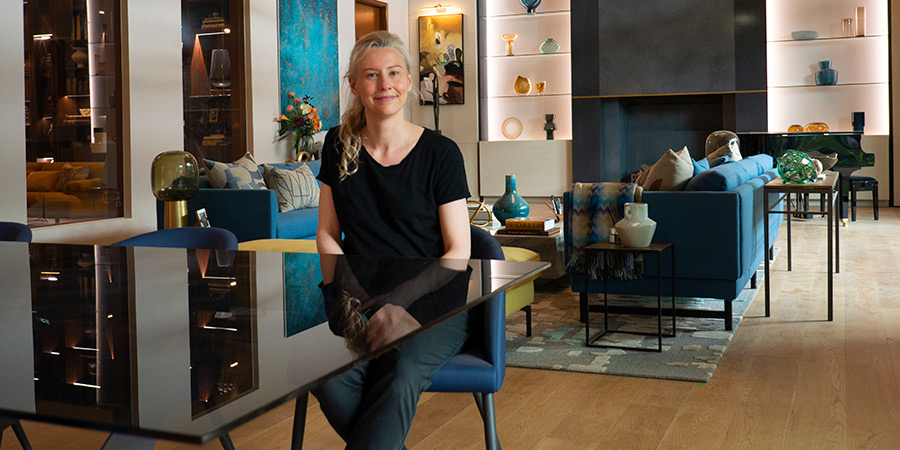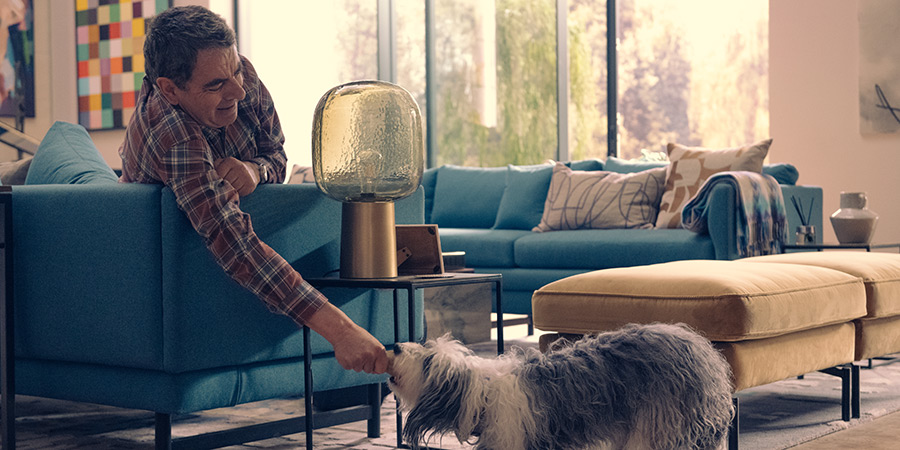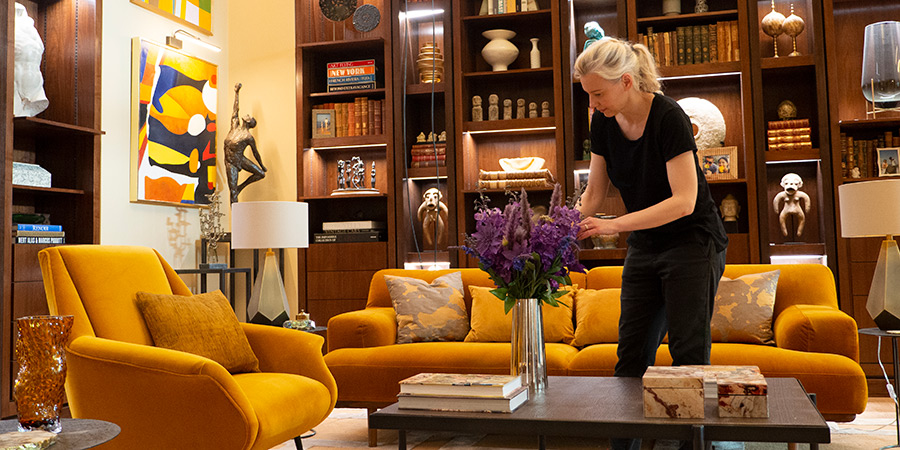Production designer Carly Reddin discusses creating the Man Vs Bee world

Production designer Carly Reddin talks us through her work on Man Vs Bee, the Netflix series in which Rowan Atkinson plays a house sitter at a extremely upmarket, luxurious, modern country mansion. This is an interesting insight into the role a production designer plays in bringing a comedy to the screen.
When did you first start working on the project?
I started soft prep around November 2020. Location manager Dan Whitty and I started scouting for a house exterior. We searched across London, Hertfordshire and Buckinghamshire, but couldn't find a house that ticked all the boxes for our show. As well as meeting practical requirements for the script (like a 3-car garage), we wanted a property with the 'WOW factor'. We had to believe that this was a desirable property that our protagonist, Trevor, would destroy.
After a couple of months, we still hadn't found the right exterior, so we made the decision to design a house from scratch! This was very exciting, as I got to really dig into a design and incorporate my love of both contemporary minimal spaces and Brutalist architecture.
When you did the first scan of the script... what leapt out at you, in terms of the job you had to do?
I already knew that I had to design the interior spaces of the house, so I was keeping a close eye on the number of rooms scripted and how much screen time would be spent in each.
I noticed the action props and how Trevor interacted with them. I realised that every prop would need a defined area within the house for one gag to move smoothly to the next one.
I recognised that the interior had to be designed big enough for Rowan to have plenty of room to perform his style of physical comedy - it had to support him but then stay out of the way.
On a practical level, the set would have to have built-in lighting.
I was also aware that matching the in-studio exterior with the real exterior would need to be handled carefully, as backcloths on studio builds can often look fake if not handled well.

How many of the decisions were already in the script; how much was up to your interpretation?
The showrunner, Will Davis, and Rowan Atkinson had very clear ideas regarding the gags in the show, so I'd always start with what was in the script first and things would naturally develop as we went along.
We did several action prop 'show and tells' during reproduction, and seeing the props in front of them sometimes inspired Rowan and Will to enact a gag another way.
I designed the dog collar, weed killer, Mondrian statue, house manual, beehives, etc, moving through several iterations. My concept designer helped explore options and communicate my ideas to the producers.
Other details were changed out of necessity, like the artwork that was originally scripted wasn't out of copyright, so it was up to my department to recommend other options.
Is it a very collaborative job?
My job is extremely collaborative. At the start of the job, I spend a lot of time with the location manager, finding and scouting the right locations for the story. I'm in constant communication with the director and producers, as it's my job to creatively translate their vision to screen.
Other key collaborators would be the DoP [director of photography], VFX supervisor and costume designer. We ensure everything works well together.
As HOD [head of department], I'm responsible for a big team, and can work with hundreds of people on one project. One of the best things about my job is meeting so many new people and learning from them as we work together.

Do plans ever change when you're on set?
Yes, regularly. Rowan can discover something new in his performance, the director may come up with a new idea, the DoP may think of an alternative way of filming something than was discussed on the tech recce, etc. It is typical to get late requests from other departments. Part of my job is to be flexible and roll with the punches.
The first shoot day, for example, was the shower scene with Rowan singing and dancing along to music. I had several discussions with Rowan, David (the director) and the producers about whether the shower glass needed a frosted panel to preserve Rowan's privacy, but the consensus was that it wasn't needed. I checked several times, because if it was required then I wanted to get it 'done properly' by sandblasting or acid etching one surface of the glass pane to create the frosted glass.
On the day before the shoot (a Sunday), the producer called to say that Rowan would like a privacy panel, so I shot off to B&Q and Screwfix to purchase as much frosted glass film as I could find. I went in early with the team the next morning and we applied the film. We didn't hold the crew up and we had solved a problem by working together. It was actually a good start to the day and the film looked great on camera.
What was the most challenging thing to achieve?
Designing the exterior and the interior of the house came fairly easily to me, mainly because I had such fun with the process, but finding the location setting for the house with the right geological and architectural features took some searching. We needed the right kind of landscape (a mature garden with a large lawn), and the right size garden to fit our huge mansion.
It was also important that the sun was in the correct orientation to the property, as the DoP needed to use natural light for the majority of the exterior shooting. Many times, locations are selected because of their east-west orientation, enabling the DoP and 1st assistant director to schedule specific shots based on the sun's position.

Lots of things got destroyed. Did you have to have lots of backups ready?
We had multiples of hero props, some in different stages of repair to fit the moment in the story. We made a replica of the Jaguar E-Type that features in the show so that Rowan could take it apart when looking for the bee and cut it with an angle grinder.
We only had one shot at filming the 'burning the house down' scene towards the end of the show, as some of the furniture was 'one-offs', expensive and designed especially for the show. I said from the start of preproduction that the burning scene had to be scheduled for the end of the shoot. It's obvious really, you burn a set down and if you want it to then look 'un-burnt', you need to spend time and money putting it back to the way it was. Or limit your shots and point away from the burnt areas, which is what we ended up doing for some additional pickup shots that were needed at the end.
Do you have any tips for anyone looking to get into TV production too, in a job likes your's?
I'd advise anyone to get some on-the-job work experience. This would give them the opportunity to observe the different roles on a film/TV set and figure out if it's for them, and which roles look the most interesting.
Try to be as helpful as possible and listen and learn. If you make yourself useful, your network will expand and more jobs will come.
In this field, experience is key. Talent can help speed the process up but, at the end of the day, you need to put in the time and learn from those in the trade.
Man Vs Bee is on Netflix now.
This article is provided for free as part of BCG Pro.
Subscribe now for exclusive features, insight, learning materials, opportunities and other services for comedy creators.

